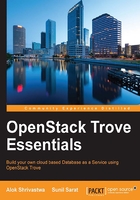
Database as a Service
Data is a key component in today's world, and what would applications do without data? Data is very critical, especially in the case of businesses such as the financial sector, social media, e-commerce, healthcare, and streaming media. Storing and retrieving data in a manageable way is absolutely key. Databases, as we all know, have been helping us manage data for quite some time now.
Databases form an integral part of any application. Also, the data-handling needs of different type of applications are different, which has given rise to an increase in the number of database types. As the overall complexity increases, it becomes increasingly challenging and difficult for the database administrators (DBAs) to manage them.
DBaaS is a cloud-based service-oriented approach to offering databases on demand for storing and managing data. DBaaS offers a flexible and scalable platform that is oriented towards self-service and easy management, particularly in terms of provisioning a business' environment using a database of choice in a matter of a few clicks and in minutes rather than waiting on it for days or even, in some cases, weeks.
The fundamental building block of any DBaaS is that it will be deployed over a cloud platform, be it public (AWS, Azure, and so on) or private (VMware, OpenStack, and so on). In our case, we are looking at a private cloud running OpenStack. So, to the extent necessary, you might come across references to OpenStack and its other services, on which Trove depends.
XaaS (short for Anything/Everything as a Service, of which DBaaS is one such service) is fast gaining momentum. In the cloud world, everything is offered as a service, be it infrastructure, software, or, in this case, databases. Amazon Web Services (AWS) offers various services around this: the Relational Database Service (RDS) for the RDBMS (short for relational database management system) kind of system; SimpleDB and DynamoDB for NoSQL databases; and Redshift for data warehousing needs.
The OpenStack world was also not untouched by the growing demand for DBaaS, not just by users but also by DBAs, and as a result, Trove made its debut with the OpenStack release Icehouse in April 2014 and since then is one of the most popular advanced services of OpenStack.
It supports several SQL and NoSQL databases and provides the full life cycle management of the databases.
Advantages
Now, you must be wondering why we must even consider DBaaS over traditional database management strategies. Here are a few points you might want to consider that might make it worth your time.
Reduced database management costs
In any organization, most of their DBAs' time is wasted in mundane tasks such as creating databases, creating instances, and so on. They are not able to concentrate on tasks such as fine-tuning SQL queries so that applications run faster, not to mention the time taken to do it all manually (or with a bunch of scripts that need to be fired manually), so this in effect is wasting resources in terms of both developers' and DBAs' time. This can be significantly reduced using a DBaaS.
Faster provisioning and standardization
With DBaaS, databases that are provisioned by the system will be compliant with standards as there is very little human intervention involved. This is especially helpful in the case of heavily regulated industries. As an example, let's look at members of the healthcare industry. They are bound by regulations such as HIPAA (short for Health Insurance Portability and Accountability Act of 1996), which enforces certain controls on how data is to be stored and managed. Given this scenario, DBaaS makes the database provisioning process easy and compliant as they only need to qualify the process once, and then every other database coming out of the automated provisioning system is then compliant with the standards or controls set.
Easier administration
Since DBaaS is cloud based, which means there will be a lot of automation, administration becomes that much more automated and easier. Some important administration tasks are backup/recovery and software upgrade/downgrade management. As an example, with most databases, we should be able to push configuration modifications within minutes to all the database instances that have been spun out by the DBaaS system. This ensures that any new standards being thought of can easily be implemented.
Scaling and efficiency
Scaling (up or down) becomes immensely easy, and this reduces resource hogging, which developers used as part of their planning for a rainy day, and in most cases, it never came. In the case of DBaaS, since you don't commit resources upfront and only scale up or down as and when necessary, resource utilization will be highly efficient.
These are some of the advantages available to organizations that use DBaaS. Some of the concerns and roadblocks for organizations in adopting DBaaS, especially in a public cloud model, are as follows:
- Companies don't want to have sensitive data leave their premises.
- Database access and speed are key to application performance. Not being able to manage the underlying infrastructure inhibits some organizations from going to a DBaaS model.
In contrast to public cloud-based DBaaS, concerns regarding data security, performance, and visibility reduce significantly in the case of private DBaaS systems such as Trove. In addition, the benefits of a cloud environment are not lost either.